
- HOME
- /
- Nihonbashi in Edo
The Formation of Edo
1590: Tokugawa Ieyasu comes to Edo, following an order from Toyotomi Hideyoshi to relocate.
1598: Toyotomi Hideyoshi dies.
1600: The Tokugawa forces are victorious over the Western Army in the Battle of Sekigahara.
1603: Tokugawa Ieyasu becomes “Seii Taishogun” (literally “Great general who subdues the barbarians”) and founds the Edo shogunate.
He orders the daimyo (feudal lords) from each area to undertake construction in Edo town, cutting through the high ground of Kandayama and reclaiming the land of Hibiya-irie inlet, so the town of Edo expands rapidly. The five major highways and the system of stations and post horses are developed.
1612: Edo is divided into neighborhoods (machiwari). Development starts from the Nihonbashi Honcho-dori area.
1615: The Toyotomi family is destroyed in the Summer Campaign of Osaka. 1635: The alternative residence system (sankin-kotai) is set out in the Laws of Military Households (Buke Shohatto), and new samurai residences for the daimyo and their families are built.
Tokinokane-dori St. Formerly: Kanetsukido-jimmichi
(the old road to the bell tower)
①Tokinokane / Yahantei
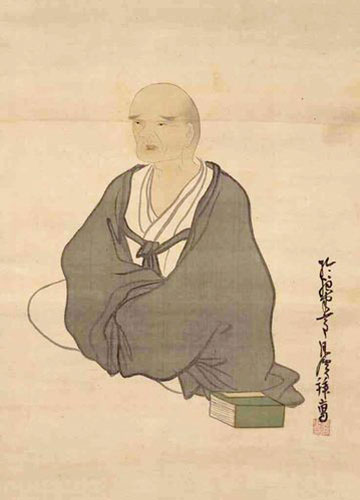
Yosa Buson “Image of Yosa Buson,” work by Goshun In the possession of Kyoto National Museum
Toki-no-Kane in Nihonbashi Hongokucho was Edo's first bell tower, set up to inform people of the time through its rings during the Edo period. A house known as the Yahantei, home to haiku poet Hayano Hajin, stood in the area around this bell tower, and the poet Yosa Buson studied haiku poetry under Hajin here.
●A verse by Buson At the convent / a cosmetic arrives / during the Ten Nights' Ceremony. trans. Cheryl A. Crowley *The Toki-no-Kane Bell Tower has been relocated to present-day Jisshi Park in the remains of Denmacho Prison
②Nagasaki-ya
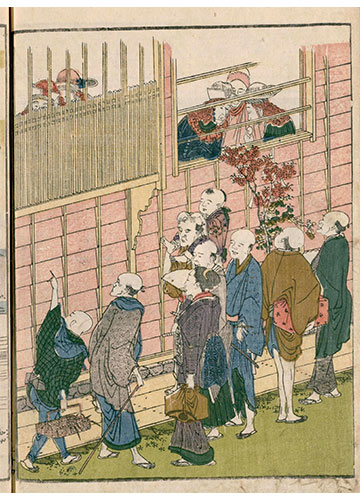
Picture of a Dutchman in Nihonbashi Nagasaki-ya Picture Book of the Pleasures of the East (Ehon Azuma Asobi) 3 volumes, work by Katsushika Hokusai National Diet Library Digital Collection
The Nagasaki-ya was an apothecary with an official relationship with the Edo government, and served as a place of lodging when the heads (Capitão) of the Dutch trading company periodically visited Edo. This store was known as the “Dejima of Edo.” It was one of the rarest places where interactions with Western civilization were possible in the state national isolation, and it is said that Japanese scholars of Dutch studies and medicine such as Hiraga Gennai and Sugita Gempaku paid visits to Seibold when he stayed there in the final years of the Edo period.
③Oyama-ya

Oishi Kuranosuke “Soga Chushingura nishikie narabi ni banzukeshu”
National Diet Library Digital Collection
The Oyama-ya was an inn thought to have stood near a long-established tempura store called Tenmo, on modern-day Toki-no-Kane-dori street. It is said that Chikara, the eldest son of Oishi Kuranosuke (famous as the former chamberlain of Ako Domain and one of the 47 ronin), stayed with a group of people here. On November 5, 1703, Oishi Kuranosuke joined the group at the inn, and 40 days later he went to have his revenge in the residence of Kira Kozunosuke in Honjo Matsuzakacho.
④Denmacho Prison
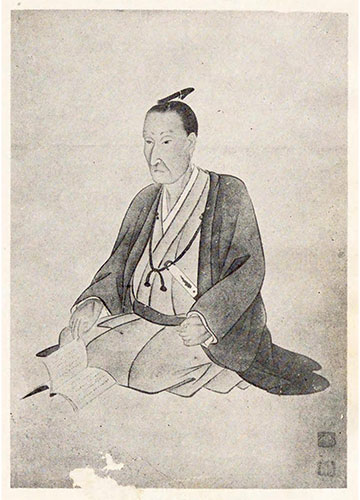
Yoshida Shoin “Yoshida Shoin” by Tokutomi Iichiro, Minyusha
National Diet Library Digital Collection
Denmacho Prison was a jail that housed prisoners. It is also the jail in which, in 1859, samurai Yoshida Shoin from Choshu Domain (Yamaguchi Pref.) was imprisoned in the Ansei Purge and executed. Shoin had a major influence on nationalist patriots who were active during the Meiji Restoration, including Takasugi Shinsaku and Ito Hirobumi (the first Prime Minister of Japan), through the Shokasonjuku Academy that he ran. Kido Takayoshi and his other students later created an alliance between Satsuma and Choshu with the mediation of Sakamoto Ryoma.
●Yoshida Shoin's death poem (a short verse left for the world before his death) Even if my body / decays on the fields of Musashi / my Japanese soul / will live forever. trans. Henry van Straelen *the engraved stone is currently in Jisshi Park.

Nihonbashi Area
Tsutaya Juzaburo
Tsutaya Juzaburo was one of Edo's foremost publishers. He released ukiyo-e woodblock print works, including those of Kitagawa Utamaro and Toshusai Sharaku, making them famous. He also established a store named “Koshodo.” Koshodo was located on present-day Nihonbashi Odenma-Honcho Dori Street, and an explanatory signboard has been created here.
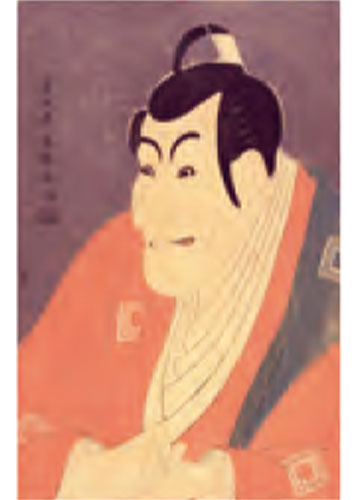
“Ichikawa Ebizo” work by Toshusai Sharaku “Ukiyo-e,” by the Ukiyo-e Preservation Publication Society/National Diet Library Digital Collection
Three Great Dojos of Edo
The three great dojos of Edo were three major kenjutsu (Japanese swordsmanship) dojos that boasted great popularity in Edo during the final years of the Tokugawa Shogunate: Chiba Shusaku's Genbukan of the Hokushin Itto-ryu style, Saito Yakuro's Renpeikan of the Shindo Munen-ryu style, and Momonoi Shunzo's Shigakukan of the Kyoshin Meichi-ryu style. People often said, “For skill, Chiba; for power, Saito; for spiritual strength, Momonoi,” and many of the people who played active roles in the transition from the late Edo period to the Meiji Restoration studied kenjutsu at these dojos. Apparently, Sakamoto Ryoma mainly trained at the Okecho Dojo of Chiba Shusaku's younger brother, Sadakichi.
Tosa Domain Nakayashiki
Samurai from Tosa Domain (Kochi Pref.) such as Sakamoto Ryoma, Takechi Hanpeita, and Okada Izo, all famous as nationalist patriots (shishi) at the end of the Edo period, lodged at the Tosa Domain Nakayashiki (in the present-day area around Chuo City Office) and focused on their kenjutsu training. The Genbukan, where Sakamoto Ryoma received his Hokushin Itto-ryu initiation and mokuroku (license), stood on modern-day Ippachi-dori street near Iwamotocho Station, and an explanatory signboard, “Remains of Genbukan and Yochijuku,” has been created here.
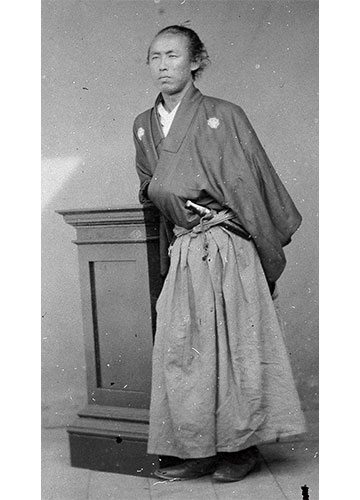
Sakamoto Ryoma In the possession of Kochi Prefectural Museum of Folk History
